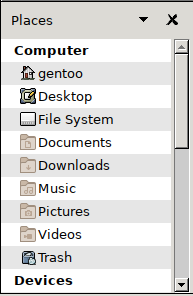If you would like your applications to draw lists like this:
...then follow these steps:
- If you want ALL lists in ALL GTK+ 3 applications to be drawn
as shown in the picture above (as opposed to just a select few
applications, mostly file manager programs, which I think deserve the
alternating colors): In your favorite text editor, open the file in
this theme package at
themes/Raleigh/gtk-3.0/workarounds/zebra-stripes.css. Look for a block that starts with:A block of code starting with/* * If you beg to differ and believe all tree views should have zebra striping, * uncomment the following code: *//*and ending with*/(each of these two markers will be on its own line) will immediately follow that note. Remove both aforementioned markers (/*and*/) surrounding the code (but do not remove the markers surrounding the note!). Save the file. - Install this theme package.
- Look for a package called
gtk3-classicin your distribution, then install it. (If for some reason your distribution doesn't have this package available, you can get it straight from the author at [https://github.com/lah7/gtk3-classic]. - Log out of your current desktop session, then log back in. (This
step is necessary; the
gtk3-classicpackage will have replaced the regular GTK+ 3 libraries installed on your system, and all GTK+ 3 applications will need to be restarted before the changes take effect.)
In GTK+ 2, many themes (certainly Raleigh) drew the rows of tree views and other lists in alternating background colors, when instructed to by the application. These so-called "zebra stripes" were useful for lists with many columns of data, since the alternately-colored lines guided the user's eye as they moved from one column to the next.
Let me show you what I mean by zebra stripes. The following is a screenshot of a GTK+ 2 application with the original Raleigh theme:
Notice how odd-numbered rows are colored slightly differently from even-numbered rows.
Unfortunately, tree views and lists are not drawn in GTK+ 3 the same way as they were drawn in GTK+ 2 -- the mechanism changed, and (in my opinion) the GTK+ 3 way is horribly broken. Officially, there is no way to replicate the zebra stripes as shown above in a GTK+ 3 application.
On top of that, applications no longer can signal to the theme that they want a specific list to be "zebra-striped" -- the method to signal such has been "deprecated" in GTK+ 3, which means that its use is discouraged -- and ever since the deprecation of that method, the method has been outright broken, too. So even if applications hinted at which lists they want zebra-striped, Gtk-Theme-Raleigh still wouldn't pick up on the message, and the theme would still have no clue as to which lists to zebra-stripe.
If the first hurdle discussed were overcome, it would be possible to simply theme all lists and tree views with zebra stripes. However, zebra stripes are not always appropriate (at least in my opinion). The following image, of the side pane of a GTK+ 3 file manager (Caja), illustrates my point. Are zebra stripes really appropriate to have here?
Fortunately, there is a solution to this problem. Some months ago, I
contributed a GTK patch to the gtk3-classic
project, that adds markers known as "style classes" to each cell in a list /
tree view before the theme draws the cell. These extra style classes provide
hints to the theme about whether the cell is part of an odd- or even-numbered
row, and whether the cell is part of the column by which the list is sorted.
The theme can then use this extra information to color the cell appropriately
and thus display zebra stripes.
There are only two problems with this approach. The first problem is that
this means that, if you want zebra stripes, you need to install the special
patched version of GTK+ 3 provided by
gtk3-classic. That might entail
compiling the code yourself. (According to the maintainer of the project,
gtk3-classic is available for several Linux distributions pre-compiled,
which means you might not need to compile it yourself.)
TIP: If you install gtk3-classic, you will probably need to log out
of your desktop and then log back in before switching to Gtk-Theme-Raleigh.
Otherwise, the zebra stripes may not appear immediately after installing
gtk3-classic.
The other problem is that, once again, Gtk-Theme-Raleigh doesn't know which lists to zebra-stripe. Right now, I implement a compromise: Gtk-Theme-Raleigh only themes the tree views of select file managers -- currently, the GTK+ file chooser dialog, Caja (MATE), Nemo (Cinnamon), and Thunar (XFCE). All other tree views lack zebra stripes.
I plan to submit a revision of my original patch to gtk3-classic, that marks
list cells with yet another style class. If this style class is present, it
means the list view has column headings (the gray buttons above the list that
label each column). If this style class is present, then it's probably a
safe bet that it would be appropriate to zebra-stripe the list in question.
Rationale: I've noticed that most GTK+ 2 applications (that I've seen) that draw column headings above a list, also request for that same list to be zebra-striped. This makes sense because normally, if a list has only one or two columns, the list probably is not very wide, column heading buttons aren't needed (their primary purpose is actually to select by which column the list is sorted), and thus one's eye doesn't need zebra stripes to follow the row from one column to another. Heck, if the list has only one column (like the Caja side pane as shown above), you don't even need to look at a second column -- you can't!
Zebra striping, believe it or not, is controversial. Some people couldn't
care less about them. Others believe zebra stripes are essential.
(Full disclosure: I personally don't care for zebra stripes, though I'll
admit that they can be useful when they are present.) GTK+ 3 doesn't make
it easy to display zebra stripes, although an unofficial means to display
them exists, in the form of the patches from the
gtk3-classic project. If there
is a pre-built version of that project available for your distribution, then
installation is simple. If not, then installation will most likely involve
compiling software yourself, which is not the most trivial task.
In the end, the choice is with you. If you absolutely must have zebra
stripes, Gtk-Theme-Raleigh has (currently limited) support for zebra stripes
just waiting for you to use, and once you install gtk3-classic (and log
out and log back in), you should have zebra stripes in your applications.
If you don't care enough about the issue, then by all means, don't bother
installing gtk3-classic. Gtk-Theme-Raleigh will look and perform just
fine without the optional dependency for zebra stripes. You'll still be
getting a far more authentic experience from this theme than from pretty
much any other GTK+ 3 theme on the Internet.
Thank you for taking the time to read this.

